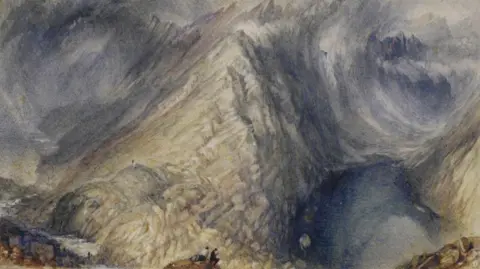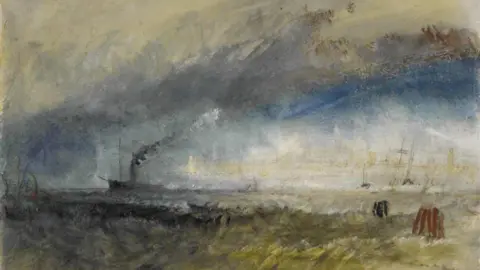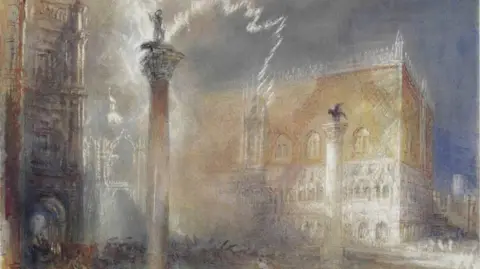Art swap brings new Turner paintings to Scotland
 Naoise Culhane/NGI
Naoise Culhane/NGIIt's been a festive tradition since 1901.
Thirty eight watercolours painted by Joseph Mallord William Turner are displayed each January in Edinburgh.
It's only been halted twice, by war and Covid but this year, there's a twist. These are Turners but not as you know them.
For the first time, the works on display at the Royal Scottish Academy in Edinburgh are from the Dublin collection while the Scottish works will be on display in Ireland.
Turner was the most famous British artist of the 19th Century, with a career which spanned half a century.
Henry Vaughan was an avid fan who collected more than 200 works and shared them between the national galleries of Scotland, Ireland and England.
He made several conditions. They should be displayed as a complete collection, for free, and only in January to protect the work from fading in direct sunlight.
 NGI
NGI"Exchanging Vaughan Bequest Turners is an idea that Edinburgh and Dublin have been discussing for a long time," said Charlotte Topsfield, exhibition curator at the National Galleries of Scotland.
"We are so excited to be working together on this historic swap in Turner's anniversary year."
The 30 works from the Vaughan request to Ireland include a stormy view of Edinburgh, captured during the artist's first visit in the summer of 1801, and not displayed in the city since.
Ms Topsfield said its inclusion in the Dublin bequest was not accidental.
"As a curator, I think Henry Vaughan thought in the way any curator thinks," she said.
"He made sure each gallery had a selection which spanned Turner's career, his technique and the places he visited so the selection in Dublin and the selection in Edinburgh echo each other in really interesting ways.
"There's a Turner for everyone whether you like detailed work or beautiful expressive quickly-painted washy watercolours and the colours are so life enhancing in the sometimes dark month of January."
That too was carefully thought out by Vaughan, the son of an industrialist who wanted to make sure the 200 delicate watercolours survived.
 NGI
NGIAs well as the 30 works from Ireland, the loan includes the original cabinet which Vaughan had made to store them.
Ms Topsfield said: "The cabinet is a beautiful piece of furniture, with an easel and storage frames which slide in and out and it really gives a sense of how a Victorian collector, particularly one as knowledgeable and passionate as Vaughan, would have looked at his collection."
A lesser known condition of his will was that when the Turners are not on display in January, they have to be kept securely but available by appointment to anyone who wants to study them.
"In the 19th Century it was common to show watercolours for very long periods," Ms Topsfield said.
"Some Victorian exhibitions would be shown in structures like greenhouses so you can imagine how much light exposure they got, and these in comparison are in the most fantastic condition."
 NGI
NGITurner was passionate and prolific, undertaking sketching tours almost every year to find new and inspiring landscapes.
He was also experimental.
His first visit to the Alps in 1802 transformed his understanding of landscape and the show includes The Great Fall of the Reichenbach, Switzerland (1802) as well as later works which show him using a variety of watercolour techniques – scratching out, sponging out and working freely in wet watercolour – to depict his beloved mountains.
2025 is the 250th anniversary of Turner's birth and the exchange is one of a number of events which will mark his contribution as the first great impressionist, and his continuing influence on artists today.
"It's a real one-off," Ms Topsfield added.
"Just to have the chance to see these works in Scotland. It felt like the right time to do something to mark that occasion."
Turner in January: Ireland's Vaughan Bequest opens at the Royal Scottish Academy building on 1 January, and is free to visit.
